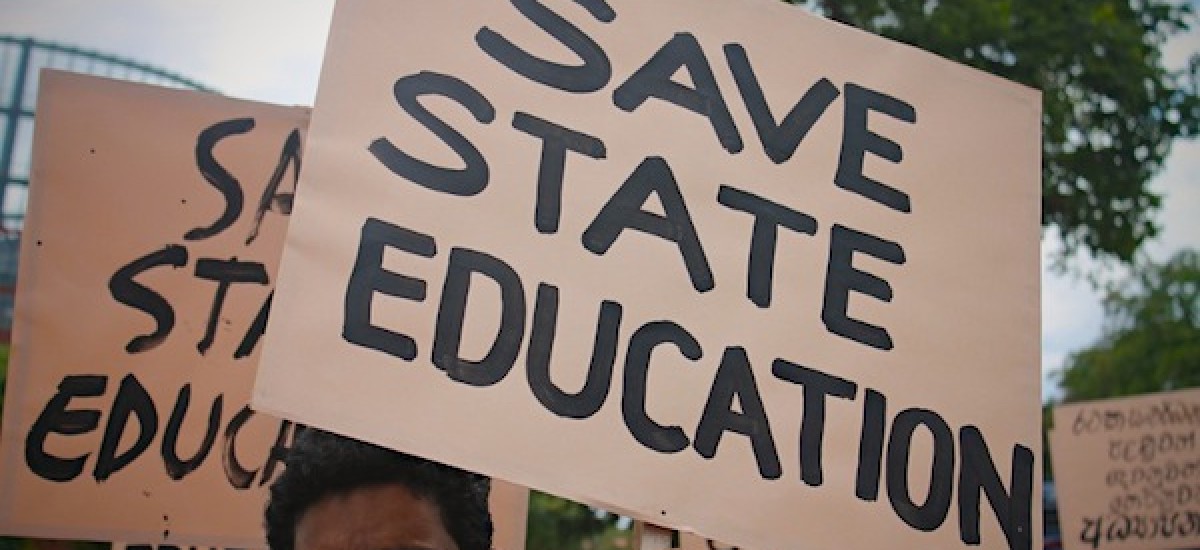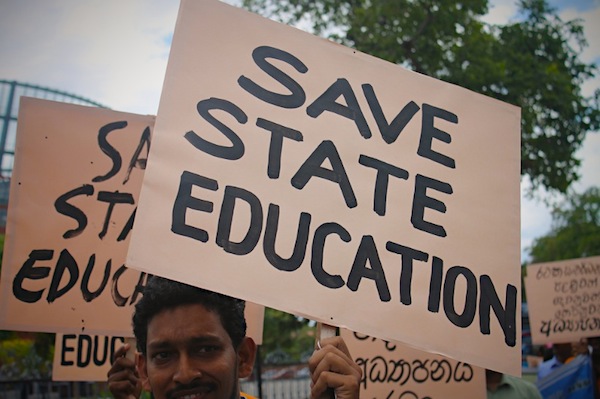Original photo courtesy Vikalpa
“It was mainly symbolic”, is how FUTA President Dr. Ranjith Dewaisiri characterized the group’s demand of “6 percent of GDP for education”, which has now gained national attention. This was in response to a question posed by an audience member during ‘THE FORUM with Eran’ held this week (26th) featuring Dr. Ranjith Dewasiri, Prof. Rajiva Wijesinha (M.P.) and Eran Wickramaratne (M.P.). The FUTA President’s comments were quite revealing, and in a sense alarming.
Much has been written already about the strike action of the FUTA and the trade union’s demands of wage hikes but also higher government spending on education (i.e., “6 percent of GDP”, according to FUTA). Questions were raised from Dewasiri on, “how did you come up with the 6 percent number, and what are FUTA’s thoughts on how to spend it?”. For both, the answer was quite non-specific and non-committal and this is disconcerting.
It is clear that FUTA has now assumed moral leadership and authority on this issue – the issue of the gross underinvestment in education in Sri Lanka. So, the fact that the group does not have any clear ideas on how a greater spending on education would actually be utilized is worrying, especially in a context where even the meager 1.9 percent current spent is allocated and spent inefficiently.
On the question of how FUTA came up with this 6 percent number, there is an important debate to be had. Unlike many other countries that are often benchmarked against Sri Lanka on the indicator of “percentage of GDP spent on education”, Sri Lanka “front loaded” a lot of its education expenditure (especially on capital investment expenditure) very early on in the post-independence period. Countries like Nepal, which one can compare against Sri Lanka to say that it spends 19 percent of GDP on education, is only now beginning to devote extensive resources to build up education. So there is a debate on who does Sri Lanka benchmark against? Is it as simple as comparing against other countries to demonstrate that we spend less? Of course, having spent large sums on education before (for which the country is reaping dividends now) is no excuse to not spend and invest any more now. Education needs are constantly evolving as economic demands and competitiveness factors change. But the nuances on numbers are worth debating and dissecting, especially with a issue like this that’s become so contentious, garnering nationwide interest.
Another issue is that the “spending on education” that FUTA refers would not, in practice, be just tertiary education. The bulk of it will be, in fact, primary and secondary education. So any demands on increasing education spending would necessarily be a concern of teachers/principals in the primary and secondary education sector as well, and is not the preserve of university academics. Is FUTA representing the thoughts of those sectors too? Are they being taken along as key partners in this debate, representing the interests of these sectors and the staff as well? Because if it isn’t, we shouldn’t expect FUTA to assume the rightful leader in this education debate, as seems to now be the case. Tertiary education is just one part of a much larger system, a system we all agree needs fixing.
Another point raised by the audience was on the role of private higher education. As readers would recall, a bill to regulate and recognize private degree awarding institutions was introduced and then shot down amidst protests by students and academics in state universities. With a growing middle class that is increasingly able to afford more private spending on higher education (not to mention other social services like health care), allowing more fee-levying private degree-awarding institutions would help free up the critically constrained state resources. These freed up financial resources could then be diverted to supporting those who most need it most – through grants, loans, scholarships, etc. to more students, and free up valuable slots in state universities for those who would otherwise have been “queued out”. A question was raised from Dewasiri on the specific objections of the FUTA to that bill, but received only a tentative response.
Another issue is that of efficient usage of existing resources – even the meager 1.9 percent. It is widely accepted that existing resources are often either wasted or allocated terribly. Improving management practices in schools and universities can help make better uses of the current meager resources. Take a simple example of teacher training programmes being scheduled during schools hours (!). This should be also part of the “education in crisis debate”, and not be limited to the sloganeering of “increase government spending to 6 percent”.
If FUTA wants to be taken seriously as the leaders in this education debate, they need a better answer on what they think would be a good way of spending a higher government allocation on education – how would they propose improving university facilities? How much would then be spent on expanding primary and secondary schools?
Why not open up the discussion on how universities can raise more money themselves and be more financial independent? FUTA also needs to answer questions on whether university academics are doing enough to help graduates be more employable, with better analytical skills and soft skills. If salary increases, as currently demanded, were granted on a performance-linked basis, would FUTA be agreeable to it?
In summary, this writer went away from The Forum on the education crisis with two key questions.
One, as highlighted above, is about the 6 percent for GDP argument – If FUTA has brought Sri Lanka’s state universities to a grinding halt for three months, and is leading a mass public movement on the education crisis, isn’t “What would you do with the 6 percent?” a very legitimate question, worth a solid answer from FUTA?
The second is – “did FUTA make a mistake by lumping up the education spending demands with their wage demands? Did they bite off more than they can chew, and is now stuck with a situation where if they get the salary hikes but not the policy changes, it will seem as if their strike action was actually just about salaries? The salary debate is a trade union issue, but the policy debate can be seen as more of a policy issue – is holding students, universities, and the government to ransom on not just the wage issue but also a policy issue the best strategy? Could FUTA have gone a better way in triggering a change on government policy towards education investment? We must remember that governments don’t like being backed-up against a corner either, especially not on hot-button policy issues. The President has clearly said he will not negotiate unless and until the strike action is called off.
But overall, we must recognize that the FUTA action is part of a broader effort of popular participation and democratization is an increasingly authoritarian governance environment. And regardless of the clarity and credibility of FUTA’s pushing of ‘hot-button’ education policy issues, the “6 percent for education” debate has raised the voice on what is possibly one of the most critical public policy matters of our time. The meagre public investment in education and the current debate surrounding it says more about state policy priorities than about how much the actual spending should be, how it should be spent. For that, FUTA must be commended.
“Our role was just to open up the debate, people can’t expect us to have all the answers”, Ranjith Dewasiri later added, in defense of FUTA’s seemingly shallow position on what is clearly a big policy matter. Although it certainly left this writer frustrated and disappointed, he does, in a sense, make a fair point. If FUTA hadn’t opened up this debate, it may have gone undebated for years. But it may be unfair (and potentially unwise) to expect FUTA alone to take this to the next level and trigger a widespread rethink of education and our broader development priorities. It now time for others to contribute. FUTA has kick-started the conversation, but what can others do to march forward? And not just with paa gamanas, but through informed analysis and debate.


